Huascaran NP
Monday, June 4th: This morning, we assembled around 5am. We started with a brief stop that seemed to have potential for owls, but did not find any. We continued through Yungay to a birding area near La Capulina. Here we ran into a big problem. The bridge was out, and the temporary bridge had a 4-ton weight limit while we were in a 9-ton bus.
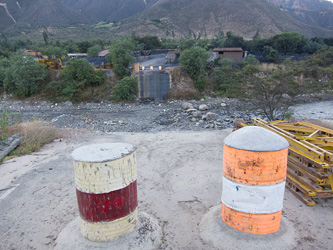 |
 |
| Bridge Out! | Temporary Bridge |
|---|
The solution was to leave the bus and walk, which we did. Various bird species were seen in some agricultural fields along the road. Of those, Blue-black Grassquit and Peruvian Meadowlark were new for the trip.
We walked about a mile, eventually climbing up a scruby hillside. After several tries, the tape brought in our target bird, the “Ancash” Canastero, an undescribed canastero that is conventionally regarded as a form of Creamy-breasted Canastero. Since the songs are different, this is almost certainly a distinct species. This form is not illustrated in the Birds of Peru.
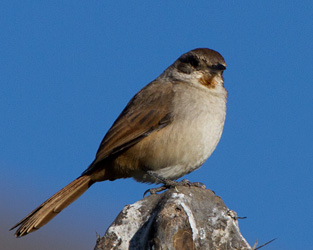 |
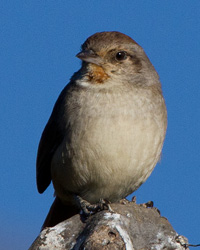 |
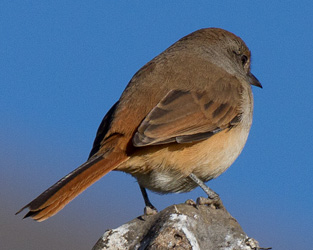 |
| “Ancash” Canastero | ||
|---|---|---|
Before we left the area, we also found at least two of the endemic Spot-throated Hummingbirds and a female Purple-collared Woodstar.
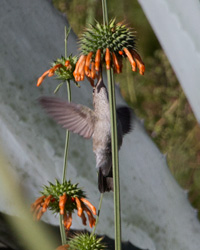 |
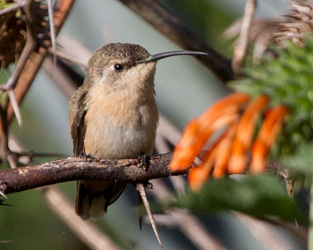 |
| Spot-throated Hummingbird | Purple-collared Woodstar |
|---|
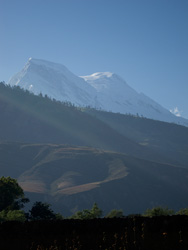 |
| Huascaran |
|---|
When we got back to the road, we hailed a taxi. It returned us to the bus. This required two trips. Breakfast was waiting for us at the bus. After breakfast we went back to Yungay and took the turn for Huascaran National Park for some high elevation birding (over 12000 feet). The road from Yungay to the park is an unpaved mountain road. Even though the distance is not far (25 km), it took almost an hour to get to the park.
We birded the area around the entrance while our drivers paid the entrance fee. We found a Black Metaltail almost immediately. Soon afterward, a Shining Sunbeam worked the area and a Black-throated Flower-piercer appeared in a nearby tree. We walked off the road into the bush in search of an inca-finch. As the group was starting this, I noticed a Plain-colored Seedeater. We had barely all gotten together off the road when someone spotted our target bird: Rufous-backed Inca-Finch. That was easy! Usually it takes some searching to find this bird.
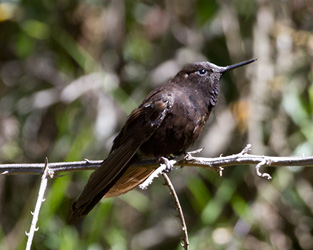 |
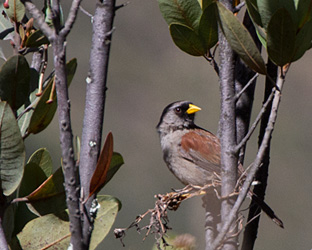 |
| Black Metaltail | Rufous-backed Inca-Finch |
|---|
We then continued into the park. This portion of Huascaran National Park goes through a very steep-sided valley named Quebrada Llanganuco. It is apparently the result of glacial action. There was only a modest slope at the edges, so it departs a bit from the classic U-shaped glacial valley (more square). I guess that's because the rock is fairly resistant, and hasn't had time to erode that much. One of the group suggested this shape may indicate the feature is actually due to a fault rather than glacial action. He may be correct. Whatever the explanation is, Quebrada Llanganuco is spectacular. It contains two lakes, Lago Chinancocha and Lago Orkoncocha.
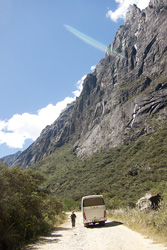 |
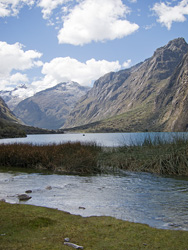 |
 |
| In Quebrada Llanganuco | Lago Chinancocha | Huascaran |
|---|
Once in the park, we tried bits of a couple of trails. The first trail yielded a several species including Striated Earthcreeper, Baron's Spinetail, and Tit-like Dacnis. We got back in the bus and continued to Lago Chinancocha. We walked over the bridge and by the picnic pavilions, finding a Great Thrush. The trail there added Black-crested Warbler and Rusty-crowned Tit-Spinetail. I was separated from the group when I saw the tit-spinetail, but we all later saw one at another location. We also found a feather from a Koepcke's Screech-Owl, but did not find the owl. The group had seen a small flock of Rufous-eared Brush-Finches while we were separated. Some of us went back down the trail to see them, successfully. On the way back to the trailhead, we were delayed by a large school group from Lima, well over 100 children (with some adults) heading down the trail. Some of them wondered whether we spoke English or French, and their greetings ranged from hola and buenas tardes, through hi and hello, to bonjour.
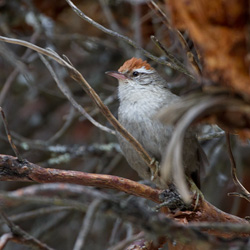 |
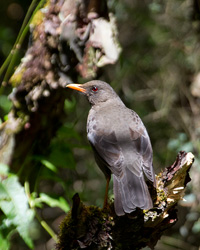 |
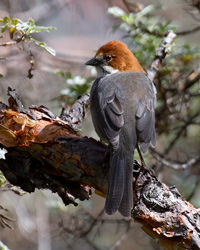 |
| Baron's Spinetail | Chiguanco Thrush | Rufous-eared Brush-Finch |
|---|
We returned to the bus and continued up the road to the far end of Lago Orkoncocha. A number of waterfowl were out on the lake. Some Brown-bellied Swallows were flying low over the water on the far side. We also found a couple of Puna Ground-Tyrants. The same area yielded another Rusty-crowned Tit-Spinetail (for the group). We heard a tapaculo calling. It eventually came in to the tape, in typical sneaky tapaculo fashion. But in the end, we all managed to get good looks at the Ancash Tapaculo.
By then it was time to head out (3pm), and we arrived back at our hotel shortly before 6.
Today's species total was 46. My trip list increased by 19 today, including 9 lifers. My current trip total is 111 species, including 34 life birds.
Andino Club Hotel, Huaraz